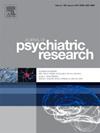首发精神分裂症患者行为控制和冲动的神经关联:基于meg的β振荡分析
IF 3.7
2区 医学
Q1 PSYCHIATRY
引用次数: 0
摘要
背景:行为控制障碍和冲动增强是精神分裂症的核心神经认知缺陷。然而,潜在的神经机制仍然知之甚少。研究具有精神分裂症遗传风险的个体可能揭示潜在的内表型,有助于早期生物标志物的识别。脑磁图(MEG)提供了在神经生理水平上研究抑制控制缺陷的高时间。本研究假设首发精神分裂症(FES)患者及其一级亲属(FDR)在行为控制任务中表现出β -波段振荡活动改变和功能连接中断,反映了抑制控制损伤和冲动性受损的明显神经特征。方法本研究包括20例FES患者、20例FDR患者和22例匹配的健康对照(hc),在MEG扫描期间执行Go/NoGo任务。分析了关键行为控制区域,特别是辅助前运动区(pre-SMA)和左运动皮质(lM1)的β -波段振荡活性和功能连通性(FC)。使用机器学习分类器来评估这些神经生理特征的判别能力。结果与hc相比,FES参与者在sma前和lM1中均表现出显著降低的β功率(P <;0.005),在抑制后期,这些区域之间的β带连通性增加(P = 0.013)。罗斯福表现出中等程度的-功率降低和FC增加,表明潜在的遗传责任。BIS-11冲动得分与两个区域的β功率显著相关(P <;0.01)。整合神经和行为特征的分类模型的原始准确率为88.7%,交叉验证准确率为72.6%,其中FES组的分类性能最高(95%)。这些发现强调了β -波段振荡和sma - lm1前连接是精神分裂症行为控制缺陷的潜在神经生理标志物。这些结果为精神分裂症冲动性的神经机制提供了新的见解,并强调了β -带动力学作为早期检测和干预的生物标志物的潜在效用。本文章由计算机程序翻译,如有差异,请以英文原文为准。
Neural correlates of behavioral control and impulsivity in first-episode schizophrenia: A MEG-Based beta oscillation analysis
Background
Impaired behavioral control and heightened impulsivity are core neurocogntive deficits in schizophrenia. However, the underlying neural mechanisms remain poorly understood. Studying individuals at inherited risk for schizophrenia may reveal potential endophenotypes, aiding early biomarker identification. Magnetoencephalography (MEG) provides high temporal to investigate inhibitory control deficits at the neurophysiological level. This study hypothesized that patients with first-episode schizophrenia (FES) and their first-degree relatives (FDR) would exhibit altered beta-band oscillatory activity and discrupted functional connectivity during behavioral control tasks, reflecting distinct neural signatures of impaired inhibitory control impairment and impulsivity.
Methods
Our study comprised 20 patients with FES, 20 FDR, and 22 matched healthy controls (HCs) to perform a Go/NoGo task during MEG scanning. Beta-band oscillatory activity and functional connectivity (FC) were analyzed in key behavioral control regions, particularly the pre-supplementary motor area (pre-SMA) and left motor cortex (lM1). A machine learning classifier was applied to assess the discriminative power of these neurophysiological features.
Results
Compared to HCs, FES participants exhibited significant reduced beta power in both pre-SMA and lM1 (P < 0.005), along with increased beta-band connectivity between these regions during the late-stage of inhibition (P = 0.013). FDR showed intermediate beta power reductions and FC increases, suggesting a potential inherited liability. BIS-11 impulsivity scores were significantly correlated with beta power in both regions (P < 0.01). A classification model integrating neural and behavioral features achieved an original accuracy of 88.7 % and a cross-validated accuracy of 72.6 %, with the highest classification performance observed in the FES group (95 %).
Conclusions
These findings highlight beta-band oscillations and pre-SMA-lM1 connectivity as potential neurophysiological markers of behavioral control deficits in schizophrenia. These results provide novel insights into the neural mechanisms underlying impulsivity in schizophrenia and highlight the potential utility of beta-band dynamics as biomarkers for early detection and intervention.
求助全文
通过发布文献求助,成功后即可免费获取论文全文。
去求助
来源期刊

Journal of psychiatric research
医学-精神病学
CiteScore
7.30
自引率
2.10%
发文量
622
审稿时长
130 days
期刊介绍:
Founded in 1961 to report on the latest work in psychiatry and cognate disciplines, the Journal of Psychiatric Research is dedicated to innovative and timely studies of four important areas of research:
(1) clinical studies of all disciplines relating to psychiatric illness, as well as normal human behaviour, including biochemical, physiological, genetic, environmental, social, psychological and epidemiological factors;
(2) basic studies pertaining to psychiatry in such fields as neuropsychopharmacology, neuroendocrinology, electrophysiology, genetics, experimental psychology and epidemiology;
(3) the growing application of clinical laboratory techniques in psychiatry, including imagery and spectroscopy of the brain, molecular biology and computer sciences;
 求助内容:
求助内容: 应助结果提醒方式:
应助结果提醒方式:


